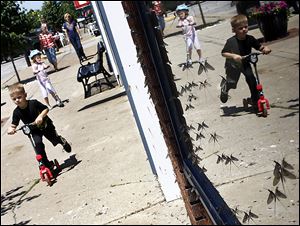
Mayflies back bugging Lake Erie area
Short-lived pesky critters spoil outdoor activities
6/20/2013
Mayflies accumulate on a downtown Port Clinton shop window where Logan Schiets, 5, of Oak Harbor, Ohio, rides his scooter. For most residents, the insects are a real nuisance.
PORT CLINTON — When Port Clinton police Chief Robert Hickman rode his motorcycle along State Rt. 2 this week, he was followed by a horde of airborne assailants.
“There were great big swarms right above my head,” he said of his night ride Tuesday. “We were hit by about a hundred.”
Chief Hickman's testimony means only one thing: The mayfly menace has returned.
Rising from Lake Erie from the end of May to early July, the insects indicate that the lake, the freshwater habitat of mayfly larva, is fresh.
But for many residents around the Western Lake Erie area, the insects are a nuisance.
They swarm under streetlights, cling onto cars, and cluster in droves on buildings and storefronts.
Quirky little fact: Their corpses stink of rotten fish, staining clothes with black splotches even bleach won't get out. And when they accumulate on the streets, drawn to the light of sodium lamps, roads get slick.
Port Clinton has been turning off its streetlights during mayfly season for 20 years to avoid car accidents, Mr. Hickman said.
“We would go to a crash scene and cruisers would get stuck on top of mayflies,” Chief Hickman said. “We would have to use a front-end [tractor] loader to get them off the street.”
Although the insects' numbers are above average this year, the number of car collisions has decreased, chief Hickman said.
Jennifer Porter, administrative assistant at Port Clinton City Hall, claims that Tuesday night was the worst, resulting in masses of mayflies as far back as Fourth Street.
The co-owner of a restaurant on the shores of Lake Erie, John Popson clears mayflies from the walls of Bootlegger's Bar & Grill every morning.
“They're horrible little beasts,” Mr. Popson admitted. “But they're a symptom of the lake being cleaner.”
Now an indication of good water quality, the mayflies were driven from Lake Erie as sewage accumulated in the water following World War II.
“Between 1955 and 1990 there weren't any mayflies in Lake Erie,” said Don Schloesser, research fishery biologist for the U.S. Geological Survey's Great Lakes Science Center.
With sewage treatment plant improvements, the mayflies began recolonizing the lake.
Ken Krieger, Heidelberg University professor and director of the National Center for Water Quality Research, said 1997, 2001, and 2005 had the largest number of mayfly nymphs in the western basin since the early 1990s.
Observing samples scooped from the bottom of Lake Erie, Mr. Schloesser estimates that this season boasts fewer mayflies than last year, part of a declining population trend over the last two decades.
“In terms of water pollution, even one year's observations aren't definitive,” Mr. Schloesser said. “I'm not sure if [the decline] is because of water quality. Fluctuations of abundance are a common occurrence in nature.”
Mr. Schloesser said invasive species such as zebra mussels and quagger mussels may compete with mayfly larvae for food, contributing to the insect's population decline.
Nichole Fifer, special events coordinator at Perry's Victory and International Peace Memorial, attributes the smaller crop of mayflies to an early spring, which may cause churning of water layers and displacement of larvae from the sediment.
Ms. Fifer is organizing this year's Return of the Mayfly Festival to educate parents and children about the insect.
The event will be held from 11 a.m. to 3 p.m. Saturday at the park's visitor center on Put-in-Bay.
Interns from Ohio State University's Stone Laboratory will give children microscope demonstrations of mayflies in different life stages.
The Lake Erie Islands Chapter of the Black Swamp Conservancy will bring snakes and spiders, and children can build bugs out of pipe cleaners and beads.
Kathie Holbrook, a Perry's Victory and International Peace Memorial ranger involved in an initiative to restore the Great Lakes, will educate visitors about invasive species not indigenous to the lake, such as zebra mussels and blue green algae.
“It's a beautiful ballet in the air. The sky is clouded with [mayflies],” Ms. Holbrook said. “They're one good sign that there's hope for the lake.”
Contact Rosa Nguyen at: rnguyen@theblade.com or 419-724-6050.